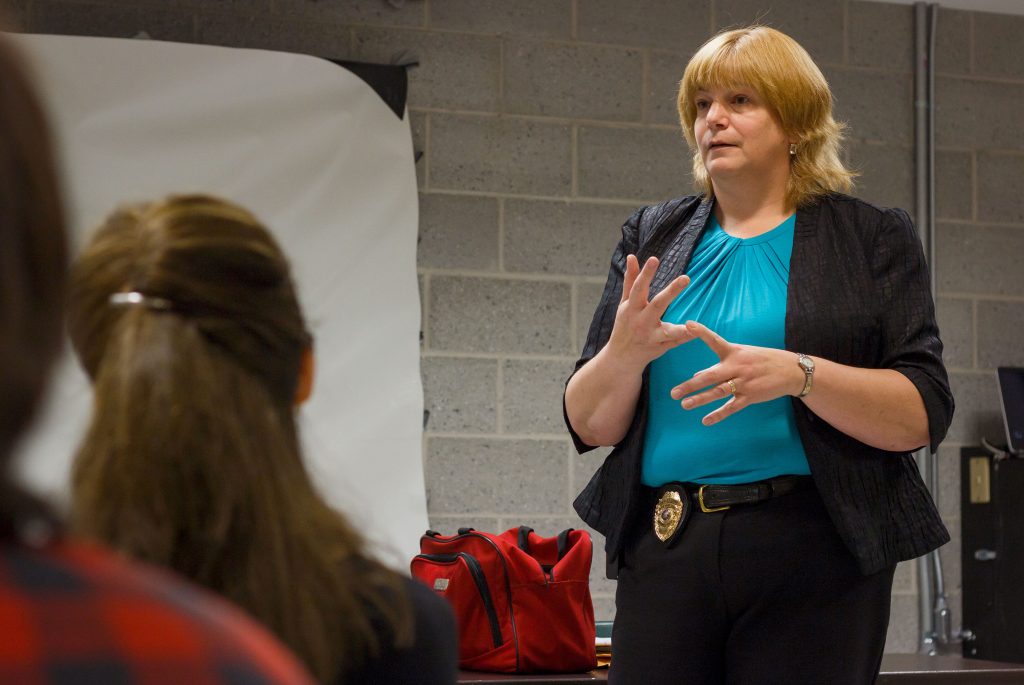
The demonstration of an active shooter situation, organized by Madeline Bay, deputy chief of police at Binghamton University’s New York State University Police, simulated what an active shooter situation would be like for attendees.
The training, held Friday, Sept. 15 on the third floor of University Union West, used the simulation, discussion and a video to teach attendees about mass shootings and how to survive an active shooter situation. According to Bay, UPD has been training students, faculty and staff for years on this topic.
“People want to be safe — they want to know how to be safe and they want to know what the University is doing to keep them safe,” Bay said. “One of the biggest fears people have at a university is an active shooter.”
A mass shooting is defined as a single incident in which at least four people are killed or injured. According to Mass Shooting Tracker, a database that catalogs such incidents, there were 477 mass shootings in the United States in 2016. There have been 239 school shootings since 2013, according to Everytown for Gun Safety, a nonprofit that advocates for gun control.
Anreka Gordon, risk management coordinator at BU’s Risk Management and Administrative Compliance office, said she attended the event to learn the best protocol for dealing with active shooters.
“It’s important,” Gordon said. “The risk of this happening is going higher and higher, so it’s important that the University wants us to be trained and equipped. It’s a preventative measure.”
One important tip is to look for warning signs such as violent behavior, suicidal tendencies and a fascination with guns.
“These situations — a lot of them can be prevented,” Bay said. “If you run into somebody who is fixated on guns or death, the best thing that you can do is report them to an RA, to a professor or to UPD. Somebody in that mindset is traumatized in some way, and we have resources that can put them on a different path and help them.”
If a shooting does occur, though, whether it’s on campus, at Walmart or a movie theater, people need to be prepared, according to the presentation. Learning the location of entrances, exits and possible hiding spots, as well as how to react to police, can save lives.
“Most times, you never know they’re coming until the first person is hit,” Bay said. “The No. 1 weapon that you are going to have is your brain. If you see something, say something. Be aware of your surroundings and think about the what-ifs.”
Shootings are often over in minutes and shooters target unlocked rooms. Depending on the situation, running away, hiding or ganging up to fight the gunman can be the best course of action, according to Bay.
“It comes down to your individual choice,” Bay said. “What are you going to do? Are you going to fight or run out the back door? You can’t second-guess yourself — they are all correct decisions.”
These decisions can be affected by how informed and prepared a person is before an active shooter situation actually occurs. Attending active shooter training sessions, watching videos about how to respond to active shooter situations and starting a conversation about active shooters among faculty and students on campus can change a person’s response so that they are able to take action quickly, and not be crippled by panic.
Elizabeth Mozer, an assistant professor of theatre at BU, said the training session influenced her choice to implement some of these strategies.
“Now I am going to look at my classrooms, entrances and exits, and determine where we could hide,” Mozer said. “Find out how to actually lock the door from the inside. Discuss this issue with students and to bring it up to my chair.”
According to Bay, the chance of a person being in an active shooter situation is about equal to an individual’s chance of being struck by lightning. Nevertheless, it never hurts to be prepared.
“At UPD, I’d rather get a thousand phone calls about someone who seems weird, and a thousand false alarms, than somebody not calling and a tragedy happening,” Bay said.
Yuri Lee contributed reporting this story.


